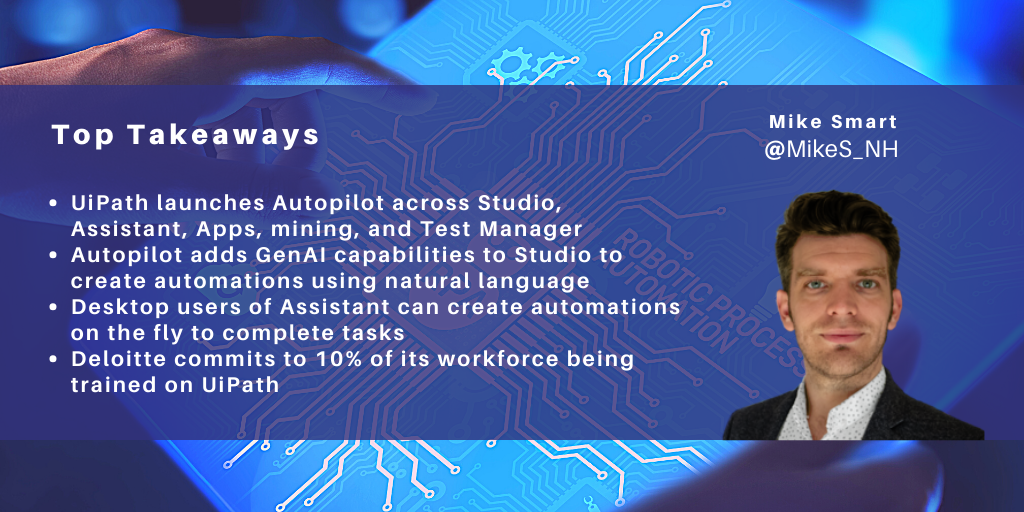Search posts by keywords:
Filter posts by author:
Related NEAT Reports
Other blog posts
posted on Oct 23, 2023 by Mike Smart

NelsonHall recently attended UiPath’s Forward VI event in Las Vegas, at which the company launched its Autopilot capabilities. While the company launched Autopilot across all its platform components, including Studio, Assistant, Apps, mining, and Test Manager, this blog focuses on its use within Studio and Assistant.
Autopilot for Studio
A constant inhibitor to automation has been the capacity of organizations to build the automations. In the early days, automation relied on skilled developers writing code to build the automation. Platform vendors such as UiPath sought to tackle this inhibitor with the launch of low- and no-code IDEs such as UiPath Studio. However, while that development launched this current wave of automation, companies were still hamstrung by the number of employees trained on these platforms who were able to deliver these results.
Seeking to increase the number of employees that could develop automations, each of the platform vendors focused on increasing support for citizen developers, with UiPath launching StudioX as a simplified version of Studio; indeed, at Forward VI, Deloitte announced that it is committing to having 10% of its 415k employees trained on UiPath as part of a citizen developer drive.
Still, these efforts have not been enough to overcome the capacity issues within clients. To address these issues, UiPath has launched Autopilot for Studio, embedding the capability for users to write requirements for bots in natural language text, from which Autopilot then generates an automation in Studio.
This will not only support citizen developers; experienced developers are often handed bots from citizen developers to ensure the bot is enterprise-grade. With Autopilot, we can expect that the quality of the citizen-developed bot is increased. The demonstrations of Autopilot at the event showed faster bot development than the typical automation developer.
Autopilot for Assistant
On the second day of Forward VI, we also saw a demo of Autopilot for Assistant. Assistant is the interface that lets desktop users see and run all the automations. For the most part, this interface has been selecting automations to run from a list of bots or leveraging the beta of Clipboard AI functionality to quickly and automatically copy information from one interface or image into fields within applications.
With the launch of Autopilot for Assistant, users can now interact through natural language with the interface. This chat interface allows Autopilot to find bots that can answer users’ requests and run desktop automations live on the machine.
Importantly, this is not where the magic ends: if a user asks for something that cannot be completed using existing bots, Autopilot can use the same intelligence used in Autopilot for Studio to create bots that can leverage connectors within Autopilot for Studio to accomplish the task, prompting the human user for confirmation along the way. If the process is successful and the user believes that this automation would be useful, they may add this to the automation hub along with an automatically generated description of the process and the steps performed so that developers can perform any ‘last mile’ work to build the bot, which can be referenced in the future.
In the demo, we saw Assistant being asked to connect with a specific person on LinkedIn. Autopilot interpreted the request, launched a browser, searched for the person, and before requesting the connection, asked the user to confirm the action. In this manner, desktop automation through UiPath assistant is less hamstrung by developers or even citizen developers.
How these developments compare to the competition
UiPath isn’t the first automation platform provider to launch a copilot for their IDEs: in May this year we saw Automation Anywhere launch its copilot capabilities, and last month, Microsoft showed its copilot for Power Automate; both strive to offer bot generation through natural language.
Where UiPath is ahead of the competition is in its secondary use case above, building bots on the fly to support digital assistants. This capability could not only boost the capability and quality of citizen developers, but reduce the need for them entirely.
Another difference we see with these offerings is their pervasiveness, with UiPath launching variants of its copilot across each platform component, including document understanding, test automation, apps, and mining.
UiPath also shared a vision for the future that we did not hear from the competition: using these generative AI capabilities to build auto-healing robots; i.e. automatically fixing aspects that have broken using bot descriptions and the AI behind Autopilot, so reducing the ongoing management cost of bots.
